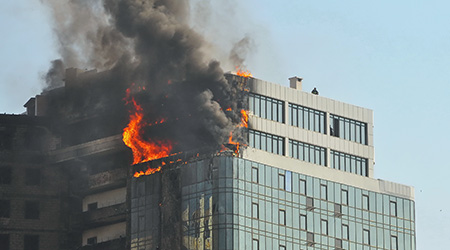Whether the crisis is severe weather or a man-made disaster, good advice is to prepare homes, cars and ourselves in case trouble strikes. Knowing this, why wouldn’t one also devote just as much energy to equipping our healthcare facilities for those same emergencies? Hospitals are often the first provision of care in communities, so facility managers must ensure facilities and organizations are ready to handle these extreme situations while also supporting a high level of care.
The Joint Commission has made emergency preparedness a national security priority because these events are becoming more frequent in the United States. Facility managers must take certain steps to train staff, apply for grant dollars and evaluate risks to withstand the impact of an impending crisis.
Document, document, document
Tornadoes ripped through the South and Midwest in December 2021, causing an estimated $18 billion in damage and economic losses and making this outbreak one of the costliest tornado events in U.S. history. During catastrophes like this, facilities cannot wait to collect information for insurance claims and federal assistance programs following a disaster. Many times, trying to retrospectively find and gather this information leads to missed information, which could lower claim or assistance payments.
To expedite this process, managers should train staff to take pictures of the facilities to have on hand before an event and then quickly document the damage in the event’s aftermath. Facility managers also should save every receipt and invoice and seek local public assistance to help demonstrate the scope of facility damage to the insurance company. And they should have a process that uses codes or keywords such as payroll, supply and contractor expenses to identify costs related to the disaster for easier identification.
Having this documentation on hand also helps facilities seek financial help from the Federal Emergency Management Agency (FEMA), which can help state, local, tribal and territorial governments, and certain private nonprofit organizations respond to and recover from catastrophes. FEMA's Public Assistance Program can reimburse expenses that private, not-for-profit healthcare systems incur after a disaster that are not covered by insurance. It also can cover service costs, including debris removal, overtime pay for workers, procurement of special equipment such as chainsaws and generators, and repairs to damaged equipment or infrastructure following hurricanes, tornadoes, earthquakes, wildfires and other such crises.
Preparing the infrastructure
Protecting facilities is another step managers should take to protect patients, families and healthcare workers. They can address the issue on an ongoing basis by ensuring the hospital is up to code. Taking proactive action to evaluate and mitigate risk can reduce further damage in the event of a disaster in or around the facility.
For example, it is a code requirement to inspect fire door latches on both sides, so if a fire were to break out, managers are certain those functions will work and protect people on the other side while also preventing further spread.
Like FEMA’s public assistance program after disasters, facilities can also receive FEMA support before disasters strike by applying for FEMA hazard mitigation grants. Many hospitals leave money on the table by not applying for this assistance because the paperwork can be cumbersome. But the additional funding could mitigate potential risks within the facility. For managers who already have documentation in order following disasters, applying for these grant dollars is even easier.
Many facility upgrades intended to negate an infrastructure risk can be costly and out of reach for some hospitals, but this funding can help break the cycle of crisis, damage, reconstruction and recurring devastation. This funding also can preserve infrastructure and ensure facilities are available during a disaster.
When the rest of the world seems to stop during and following a catastrophic event, healthcare facilities must be available to care for those impacted. As healthcare leaders, managers have a great public responsibility to prepare hospitals physically and financially to weather the next storm.
Scott Cormier is vice president of emergency management, environment of care and safety at Medxcel. He specializes in facilities management, safety, environment of care, and emergency management and provides healthcare service support products and drives in-house capabilities, saving and efficiencies for healthcare organizations that improve the overall healing environment for patients and staff. Cormier leads the development and implementation of emergency management, general safety and accident-prevention programs for the national network of hospitals Medxcel serves.

 Grounding Healthcare Spaces in Hospitality Principles
Grounding Healthcare Spaces in Hospitality Principles UC Davis Health Selects Rudolph and Sletten for Central Utility Plant Expansion
UC Davis Health Selects Rudolph and Sletten for Central Utility Plant Expansion Cape Cod Healthcare Opens Upper 2 Floors of Edwin Barbey Patient Care Pavilion
Cape Cod Healthcare Opens Upper 2 Floors of Edwin Barbey Patient Care Pavilion Building Sustainable Healthcare for an Aging Population
Building Sustainable Healthcare for an Aging Population Froedtert ThedaCare Announces Opening of ThedaCare Medical Center-Oshkosh
Froedtert ThedaCare Announces Opening of ThedaCare Medical Center-Oshkosh